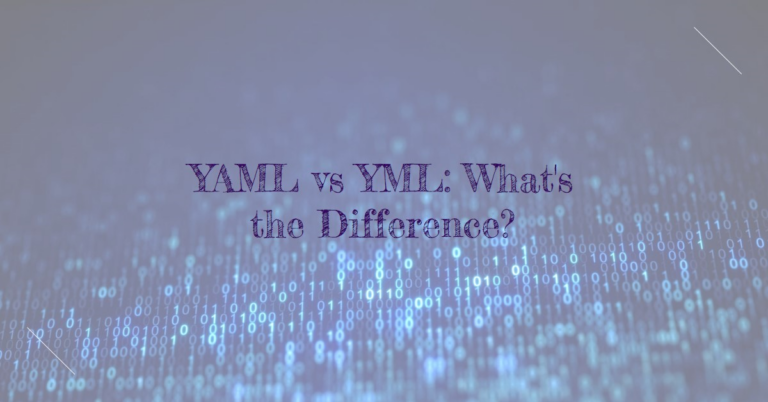YAML, a human-readable data serialization format, simplifies complex data structures, making them easy to read and understand. Developers often encounter two file extensions for YAML: .yml and .yaml. This article delves into the distinctions between these extensions, exploring their historical origins and providing guidance on when to use each. As we navigate through the nuances of yml vs yaml, we aim to offer clarity and insight into best practices for utilizing YAML in your projects.
Table of Contents
What is YAML?
YAML, which stands for “YAML Ain’t Markup Language,” is designed to be easily readable by humans and interpreted by machines. It is often used for configuration files, data exchange between languages, and as a basis for more complex data formats.
Historical Background
The development of YAML began in the early 2000s, with the first specification released in 2001. Initially, YAML was perceived as a markup language, similar to XML, but it was later redefined to emphasize its data serialization capabilities. This shift highlighted YAML’s flexibility and its ability to handle complex data structures in a straightforward manner.
Significance in Modern Development
YAML’s significance in modern software development cannot be overstated. It is widely used in:
- Configuration management: Tools like Ansible and Docker compose files often use YAML for defining configurations.
- Continuous Integration/Continuous Deployment (CI/CD) pipelines: Platforms like GitHub Actions and GitLab CI define their workflows in YAML.
- Cloud services configuration: Services like AWS CloudFormation and Kubernetes use YAML for defining resource configurations.
The adoption of YAML across various tools and platforms underscores its utility in simplifying complex configurations and enhancing the readability of data. Its evolution from a simple markup language to a cornerstone of modern development practices demonstrates its versatility and enduring relevance in the tech industry.
The .YML vs .YAML File Extension Debate
The choice between .yml and .yaml extensions has its roots in historical practices and preferences. Initially, the .yml extension gained popularity due to the DOS 8.3 filename convention, which limited file names to eight characters with a three-character extension. This convention influenced early Windows programmers, leading to the widespread adoption of the .yml extension for YAML files.
However, the official stance of the YAML FAQ, established in September 2006, recommends using .yaml to clearly represent YAML Ain’t Markup Language. This recommendation aims to standardize the file extension and avoid confusion.
Choosing between these extensions has practical implications:
- Compatibility and Developer Preferences: Some tools and platforms may have a preference or requirement for one extension over the other, affecting integration and workflow.
- Impact on Project Conventions and Tooling Support: The choice of extension can influence project conventions, with some communities or tools advocating for one standard to ensure consistency and ease of use.

Industry Practices and Examples
The debate over yml vs yaml is reflected in the practices of various projects and tools:
- Symfony2 and its YAML component initially used
.yml, aligning with its concise syntax philosophy. - Microsoft Azure DevOps defaults to
azure-pipelines.ymlfor CI/CD pipeline definitions, showcasing the extension’s prevalence in industry tools.
However, there’s a noticeable shift towards the .yaml extension:
- Docker-compose transitioned from
.ymlto.yamlin later versions, though it still supports.yml, demonstrating a move towards standardization.
The role of community and developer awareness in this transition cannot be understated. As more developers and projects adopt the .yaml extension, it fosters a unified approach to using YAML, enhancing readability and reducing confusion across different platforms and tools. This trend towards standardization reflects a broader understanding of the importance of clear and consistent naming conventions in software development.
Best Practices for Developers
Developers should lean towards using .yaml for new files, aligning with the official YAML recommendation. This choice promotes clarity and consistency across YAML documents. When creating new YAML files:
- Prefer
.yamlto adhere to the standardized extension, enhancing readability and future-proofing your projects. - Be permissive with
.ymlfiles when dealing with existing projects or external inputs, ensuring compatibility and flexibility. - Document your choice of file extension within your project’s documentation to clarify your rationale and maintain consistency for all project contributors.
FAQs
Is there a technical difference between .yml and .yaml files?
No, the difference is purely in the file extension; the content format remains the same.
Why do some projects use .yml while others use .yaml?
Historical practices and individual or tool-specific preferences influence the choice of extension.
Can I switch from .yml to .yaml without affecting my project?
Yes, but ensure all references to the file within your project are updated accordingly.
How do file extensions affect YAML parsing and tool compatibility?
Most tools and parsers treat both extensions equally, but some may have a default or preferred extension.
What should I use for my new project, .yml or .yaml?
Prefer .yaml for new projects to align with the official recommendation and ensure clarity.
Throughout this discussion on the .yml vs .yaml debate, we’ve explored the historical context, practical implications, and industry practices surrounding YAML file extensions. By adhering to community standards and recommendations, developers can ensure consistency, clarity, and compatibility across their projects. As the tech community continues to evolve, making informed decisions based on established best practices will foster a more unified and efficient development environment.

